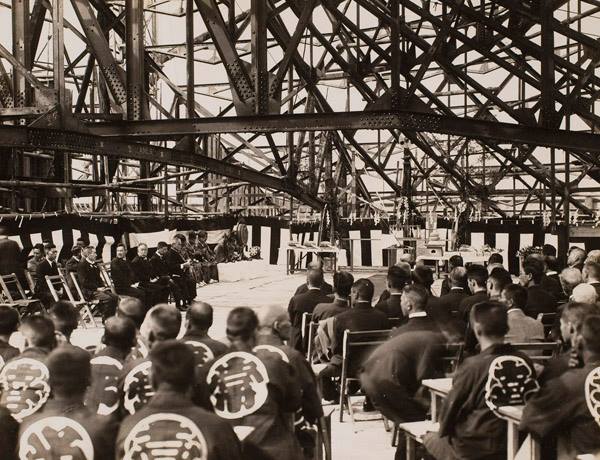Back cover

The Framework Completion Ceremony (Jōtōshiki) for Yasuda Auditorium (1924)
Precipitated by the donations for a large hall and a binden (temporary resting quarters for the Emperor) from Yasuda zaibatsu founder Zenjiro Yasuda, the construction of Yasuda Auditorium was completed in 1925. Shimizu-gumi (currently Shimizu Corporation) was in charge of building the structure, with Professor Yoshikazu Uchida and others from the Faculty of Engineering’s Department of Architecture responsible for its design. By situating the Auditorium at the end of a ginkgo-lined avenue and later placing the Faculty of Engineering’s Head Administration Office (Reppinkan), buildings housing the Faculty of Law and Letters and other such structures to its left and right, Professor Uchida’s group intended to evoke a sense of dignified magnificence. The Auditorium’s exterior, covered in dark brown tiles and featuring a four-sided clock tower reaching for the sky, exudes a unique architectural atmosphere combining German Expressionism with the Professor’s so-called “Uchida Gothic” style. Yasuda Auditorium became the focal point of an intense struggle during the 1968 University of Tokyo Protests (Todai funsō), and was afterwards closed for a long period as a result. The structure underwent a major renovation in 1990 and once again became the location of the University’s commencement ceremony from 1991 onwards. Yasuda Auditorium was registered as a Tangible Cultural Property of Japan in 1996 and is currently undergoing a full renovation. In addition to improved earthquake and disaster resistance as well as accessibility, the Auditorium is being completely altered to closely match its original design plans. This large-scale project is expected to reach completion this December. Yasuda Auditorium, after experiencing its own renovation, will continue to watch over UTokyo’s innovation.




